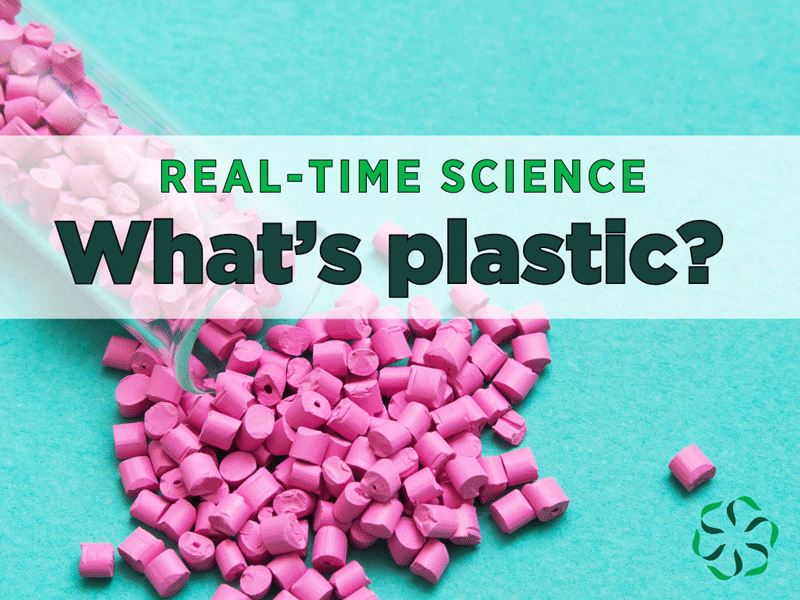This seemingly innocuous question is complicated. In this post, we will explore the current definitions and understanding of plastics.
What is plastic?
There is no singular agreed-upon definition for plastic. Plastics, as a term, is used to describe a vast array of materials composed of polymer-containing compounds.
Generally, folks consider plastic to be synthetic or semi-synthetic polymers that are lightweight, strong, durable, and, when desired, flexible. Polymers identified as plastics can be made by extrusion, injection molding, vacuum forming, and compression to make fibers, thin sheets, and other specific objects.
What is a polymer?
Before discussing polymers, we need to discuss their building blocks, monomers.
Let’s look at monomers.
Monomers are compounds that can be interconnected through chemical reactions. When you string together four or more monomers, you create a polymer.
Common monomer compounds include
- Ethylene: Ethylene is the monomer for polyethylene. We use polyethylene to create packaging, containers, pipes, and more.
- Propylene: Propylene is the monomer for polypropylene. We use polypropylene to make automotive parts, textiles, packaging, and more.
- Vinyl Chloride: Vinyl Chloride is the monomer for polyvinyl chloride (PVC). We use PVC in construction materials like pipes, cable insulation, window frames, and more.
- Styrene: Styrene is the monomer for polystyrene. We use polystyrene to create products like foam insulation, disposable cups, containers, and more.
- Acrylonitrile: Acrylonitrile is the monomer for polyacrylonitrile. Polyacrylonitrile is used to make synthetic fibers like acrylics and carbon fibers, as well as to make heat-resistant components for aerospace applications.
Let’s look at polymers.
Polymers are compounds containing four or more monomers. Thousands of polymers exist.
Polymers differ in their composition, degradability, biodegradability, structure, function, solubility, and more.
There are two general categories of polymers: naturally occurring polymers and synthetically created polymers.
- Natural polymers include proteins, nucleic acids (like DNA and RNA), polysaccharides (like cellulose and starch), silk, wool, and more.
- Synthetic polymers include nylon, polyethylene, resins, rubbers, and more.
Some polymers, like polyvinyl alcohol, will dissolve in water over the course of days, while other polymers, like HDPE pipes, may maintain their structure and function for thousands of years.
Is there a legal definition of plastic?
Some states, like Illinois, defined a microbead as a specific type of plastic, but federally in the United States, there isn’t one readily available, legally agreed upon definition of plastic.
What do I need to know about plastics and polymers?
Overall, marketing labels and general terms can make understanding a specific product’s complete health and environmental implications challenging. Like how the term “all-natural” does not mean a product is ideal for your health; plastic doesn’t mean a product will harm your health or the environment.
We must look at the material to understand its potential health and environmental consequences.
Some polymer-based products are persistent in the environment and will take thousands of years to break down. Other polymer-based products will dissolve and biodegrade entirely in water in a few days’ time.
We cannot say all polymers and plastics cause harm simply because they share a definition or a marketing term. Again, we must look at the specific material to understand the long-term and short-term outcomes.
Are some polymers and plastics better than others?
Yes. Specific materials are developed and used to meet particular needs. Each polymer or plastic will only fulfill some use cases.
As we continue to understand how specific polymers and plastics impact human health and our environment, we can use new technologies, like green chemistry, to develop environmentally conscious polymers and plastics that remain safe for humans.
The good news.
Plastics play a significant role in every aspect of human life; from life-saving medical advancements to the materials that keep our foods and beverages safe from contamination to lightweight and durable building materials, plastics are all around us.
Globally, researchers are committed to making polymers and plastics safe for humans and the environment. And at CRIS, we’ll continue to look at the latest research and share the latest science.
If you have any questions about foods and ingredients, please reach out to us via email or submit your idea to us at go.msu.edu/cris-idea.

